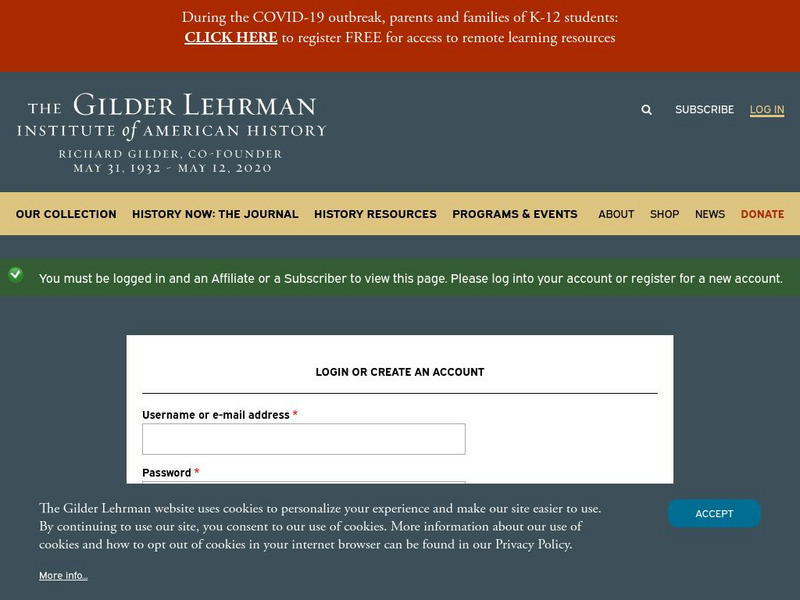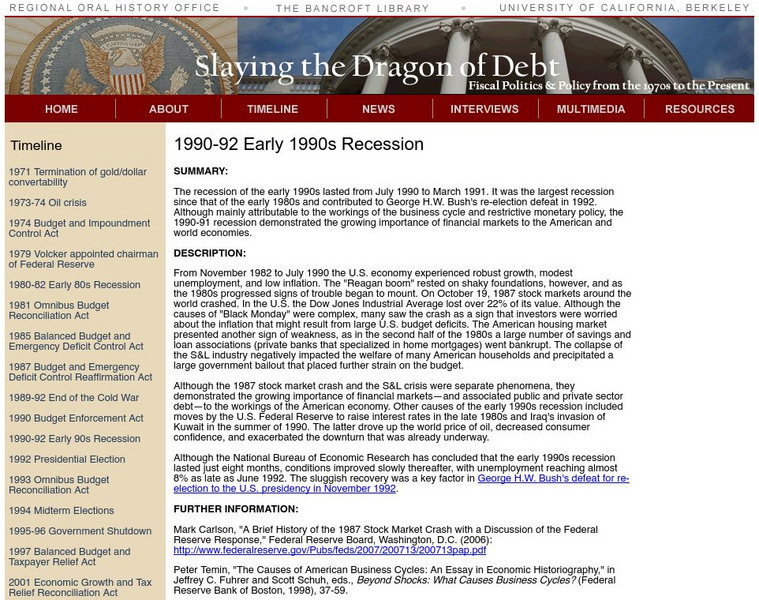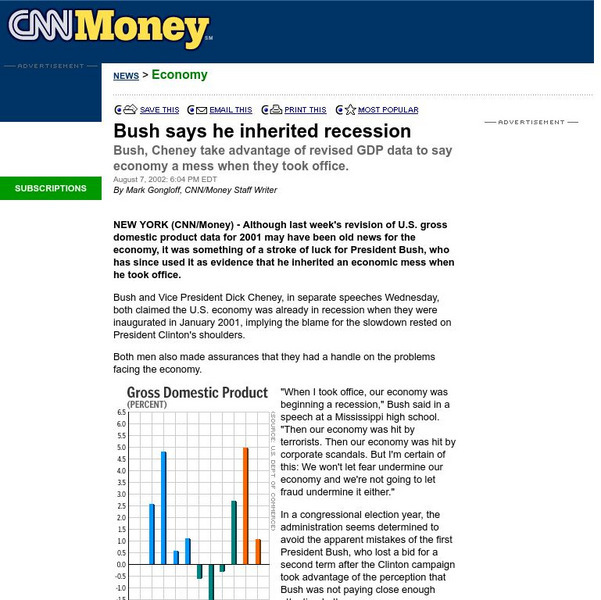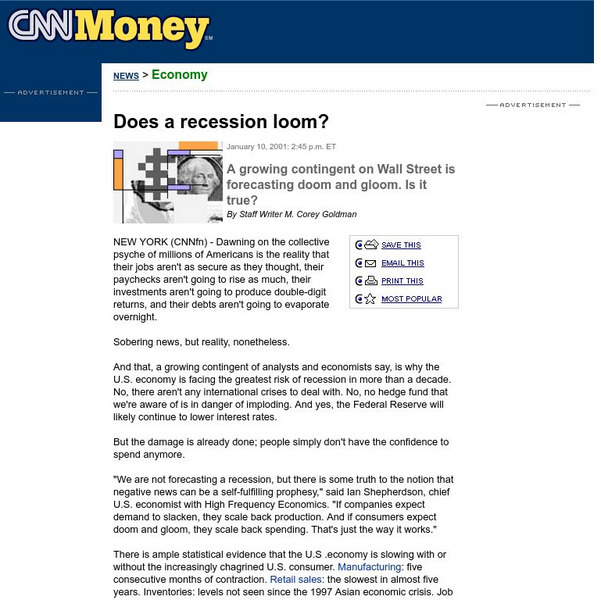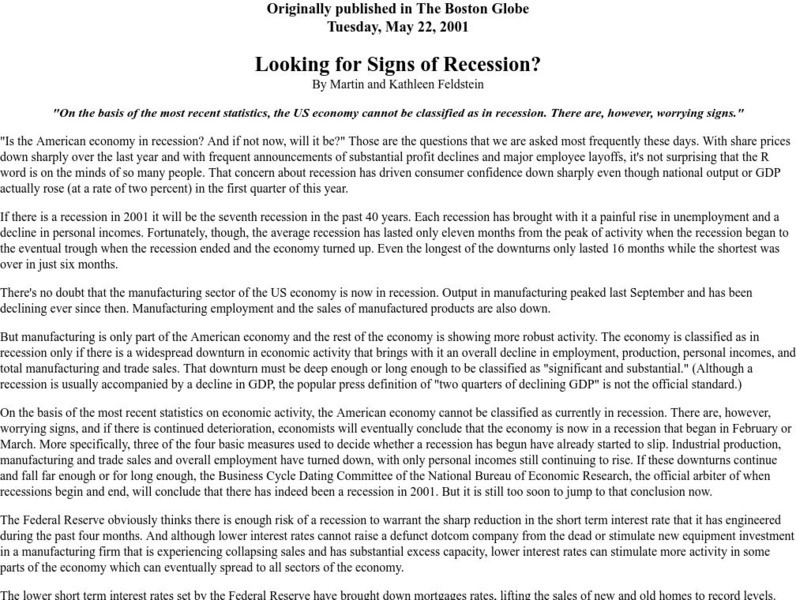US Department of Labor
Bureau of Labor Statistics: Monthly Labor Review: Earnings and Employment Trends in the 1990s [Pdf]
An article excerpt that compares earnings in the 1990's to the growth in employment. Requires Adobe Reader. [PDF]
PBS
Frontline: Inside the Meltdown
A fascinating report complete with interviews of those closest to the matter, videos, etc. regarding the 2008-2009 economic crisis is provided by Frontline.
Other
Amos Web: A Pedestrian's Guide to the Economy
Exploring the economy can be a fun adventure with the Pedestrian's Guide to the Economy. Use this site to find your answers to economic topics in a user-friendly format with comic strip guides.
Khan Academy
Khan Academy: The Presidency of George W. Bush
September 11, 2001 occurred in the early days of George W. Bush's administration and set the tone for his presidency. Study his domestic and foreign policy by reading the following summary, answering critical thinking questions, and...
Gilder Lehrman Institute of American History
Gilder Lehrman Institute: History Now: The New Deal
[Free Registration/Login Required] Read about the New Deal, its programs, and the ways it helped a nation in the grips of the Great Depression. The New Deal was not universally popular, so find out what Franklin Roosevelt did to keep the...
Other
Texas Wide Open for Business: State to State Comparison [Pdf]
A graphical comparison of employment data that shows how well Texas fared between 2008-20013 (before and after the recession), against how poorly other states fared.
Federal Reserve Bank
Federal Reserve Bank of Minneapolis: There's No Such Thing as a Good Recession
This article from the Federal Reserve Bank of Minneapolis discusses how a recession effects the economy. It goes into great detail on why a recession can never be a good thing. (Published Sept. 1, 1989)
Federal Reserve Bank
Ask Dr. Econ: How Many Recessions Have Occurred in the u.s. Economy?
Resource takes a look at the period from the 1940s to the end of 2007 and explores in depth the topic of recessions and how many have actually occurred.
Khan Academy
Khan Academy: The Building Blocks of Keynesian Analysis
Keynesian economics focuses on explaining why recessions and depressions occur and offering a policy prescription for minimizing their effects. The Keynesian view of recession is based on two key building blocks: recessions occur when...
Digital Public Library of America
Dpla: The Panic of 1837
This set uses primary sources to explore the financial practices that contributed to the Panic of 1837 and the impact of the crisis on America's politics, economy, and people.
Khan Academy
Khan Academy: The Phillips Curve in the Keynesian Perspective
Read about how we can use the Keynesian perspective to think about the common tradeoff between low inflation and low unemployment.
University of California
Roho: 1990 1992 Early 1990s Recession
A brief description of the recession at the end of George H.W. Bush's presidency, its causes, and results.
PBS
Pbs Online News Hour Extra: u.s. Economy Officially in a Recession
The verdict is in and the U.S. is in a recession. Find a succinct explanation of the 2008 recession and backtrack to the Great Depression. Follow up with discussion questions and a lesson plan complete with a glossary of terms. December...
US Department of Labor
Bureau of Labor Statistics: 1990 91 Recession: How Bad Was the Labor Market? [Pdf]
"The 1990-91 recession: how bad was the labor market?" by Jennifer M. Gardner, from Monthly Labor Review Online, June 1994, Vol. 117, No. 6.
CNN
Cnn Money: Bush Says He Inherited Recession
CNN article discussing the origins of the 2001 recession. According to Bush and his administration, the US was already in recession when they came to power in January 2001.
CNN
Cnn Money: Does a Recession Loom?
What caused the economic recession of 2001? According to this CNN Money article, a lack of consumer confidence to spend money, poor corporate performace, contraction in the manufacturing and retail sales sectors, and job layoffs.
Other
Nber: Looking for Signs of Recession?
From March 2001, this National Bureau of Economic Research article examines the worrisome signs that a recession may not be too far off in the future. Worrisome signs include decreased manufacturing levels, industrial production, and...
Digital History
Digital History: The Depression of 1937
Read about the "Roosevelt Recession" that resulted from the slashing of government spending because of rosy economic news in 1936. Find out how opposition to the New Deal kept it from being expanded to help the country out of recession...
Other
Federal Reserve Bank of Kansas City: The Federal Reserve System
The site maintained by the Federal Reserve District explains monetary policy, and supervisory and regulatory role of the U.S. Federal Reserve System.
Independence Hall Association
U.s. History: A Baby Boomer in the White House
Read about the presidential election of 1992, which included a third-party candidate, focused on the economy, and unseated an incumbent.
Texas Education Agency
Texas Gateway: Ch. 13: Money and Banking: The Role of Banks
By the end of this section, you will be able to do the following: Explain how banks act as intermediaries between savers and borrowers; evaluate the relationship between banks, savings and loans, and credit unions; and analyze the causes...
PBS
Pbs: The Lowdown: Poverty Trends: What Does It Mean to Be Poor in America?
Use math to learn about changes in US wealth distribution and poverty rate over time in this interactive from KQED. In the accompanying classroom activity, students interpret the graphs and consider how the poverty rate spike following...
Texas Education Agency
Texas Gateway: Chapter 11: Introduction to the Keynesian Perspective
In this chapter, you will learn about the following: Aggregate demand in Keynesian analysis, the building blocks of Keynesian analysis, the expenditure-output or Keynesian cross model, the Phillips curve, the Keynesian perspective on...
![Bureau of Labor Statistics: Monthly Labor Review: Earnings and Employment Trends in the 1990s [Pdf] Handout Bureau of Labor Statistics: Monthly Labor Review: Earnings and Employment Trends in the 1990s [Pdf] Handout](https://static.lp.lexp.cloud/images/attachment_defaults/resource/large/FPO-knovation.png)



